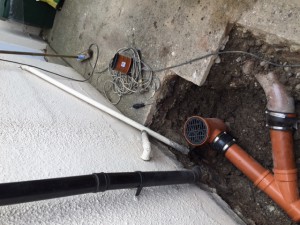I thought chalk was good for drainage?
Well, you’re right in some cases. If it’s broken up first, or it’s bored through with an auger to access a strata more suitable for drainage (preferably not clay) . It’s like concrete is great for drainage, if you break it up into hardcore first.
Below: The installation of a new bottle-gully in a property in Walderslade.

So you’re going to suggest, if you’ve got rising damp you need a chemical injection DPC putting in ?
No, that’s not what i’m insinuating at all. In fact forget about Chemical DPC’s completely for a minute. Ok, they have there place, but it’s the wrong methodology and the wrong mindset at this stage. You see, what most (probably all) damp-proofing firms will tell you is the DPC has “worn out” because it’s “old”.
A DPC is sandwiched between two courses of brickwork; unless you bridge it or breach it in some way, it will remain in-situ and as effective as the day it was put in.
DPC’s were originally slate and that slate remained consistently water resistant below ground-level for millions of years before being dug-up out of the ground.
Later DPC was bitumen, or a fibrous bitumen. There were many variations, but on the whole the same rule applies. As long as it’s not bridged with an elevated exterior ground-level or breached by drilling through to put in a waste pipe, it will remain effective.
There’s a common belief (misconception) that has been given a degree of misguided credibility that “there is no such thing as rising-damp”.
The media has picked up on this as have a number of ‘experts’. It stems from the fact that we (the British) are in a minority in Europe (and indeed wordwide) who historically actually have DPC’s within there properties. Apparently its found quite comical that we have found it necessary to install a damp proof course.
This may or may not be true. My expertise does not extend to building practices abroad. The point being, it’s entirely irrelevant to what works abroad, in a different climate, with different materials on a different sub-base.
There is so-called scientific proof that moisture will not rise through masonry as predicted if a brick wall is immersed in water. The most common example of this is where brick work rises from a river to support a bridge. It is asked, why does the water not saturate the brick work throughout the bridge and affect the structural integrity as predicted if rising-damp is real ?
The example of a bridge is of course not compatible with the example of a house. The is no accounting for the density of brickwork, the strength of the mortar mix and most importantly the fact that the bridge brickwork would register as saturated on a Protimeter reading. A house of course has a plastered internal surface which is then painted or wallpapered. If the moisture content in the masonry of a house is raised marginally, the results are easily identifiable upon the walls surface. To summarise, the DPC is essential. The DPM (damp proof membrane) perhaps less so, but more on that later.
So, let’s get back to the revelation that Medway properties have historically been built upon a what is essentially an impermeable barrier.
Below the concrete surface of the ground-level and above the chalk, the brickwork below ground-level is in direct contact with usually clay heavy water-sodden soil.
Above:connecting into a pre-existng manhole.
